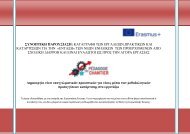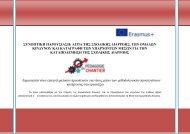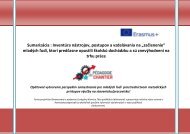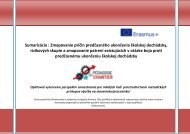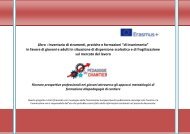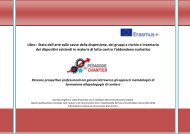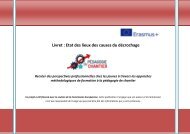Livret Inventaire EN
Analysis of the causes for school dropout, risk groups and inventory of existing me asures in the fight against early school leaving
Analysis of the causes for school dropout, risk groups and inventory of existing me asures in the fight against early school leaving
You also want an ePaper? Increase the reach of your titles
YUMPU automatically turns print PDFs into web optimized ePapers that Google loves.
Booklet : Inventory of tools, practices and trainings promoting integration for young<br />
adults who dropout and are in a weak position on the labour market<br />
Recreating career prospects for young people throughout training methodological<br />
approaches to the Pedagogie de chantier (learning by doing)<br />
This project has been funded with support from the European Commission.<br />
This publication reflects the views only of the author, and the Commission cannot be held responsible for any use which may be<br />
made of the information contained therein
Preamble<br />
This booklet is an overview of 2nd intellectual output of our project : Inventory of tools, practices and<br />
trainings promoting integration for young adults who dropout and are in a weak position on the labour<br />
market<br />
For detailed information you can acces the overall report on our website http://pedachantier.eu,<br />
2
I. Inventory of tools, practices and trainings promoting integration for<br />
young adults who dropout and are in a weak position on the labour<br />
market<br />
This annex introduces the synthesis (an abbreviated version) of the intellectual production O2 of the<br />
project Educational Working approach “Inventory of the tools, practices and inclusion training” in<br />
favour of young adults in situation of school dropout and weakening on the job market” realized in the<br />
framework of the EU project “Pedagogie de chantier (learning by doing)” financed by the Erasmus +<br />
program. The whole report is available from every project partner.<br />
3
After a preliminary situational analysis of school dropout causes, groups at risk and to a census of<br />
existing system fighting against school dropout in every partner’s area (above deliverable 01), the<br />
project partners compiled an inventory of “inserting” practices in favor of young adults in a position of<br />
school dropout. These results will be used as a basis for the training model “To train professionals to<br />
the Pedagogie de chantier (learning by doing)” (O3) and allow to draw the environmental conditions to<br />
favour the experimentation:<br />
• Different roles, actions and targets of structures;<br />
• Characteristics of target groups<br />
• Potential obstacles to the setting of a developed system<br />
• Socio-economical context<br />
4
This O2 report begins with a synthetic reminder of national educational, training and inserting<br />
framework and professional insertion of young adults in position of school dropout. It shows a general<br />
table of approaches followed by partner countries of the project Pedagogie de chantier (learning by<br />
doing). In most countries, it seems necessary to improve the watch, the gathering and the analysis of<br />
data to develop targeted and efficient politic. The conclusion of this part confirms the previous<br />
observation (deliverable O1), as rephrased bellow:<br />
The strengthening of a public policy fighting against school dropout is necessary to all institutional<br />
actors covered by the Pedagogie de chantier (learning by doing) project. This policy should associate<br />
every institutional but also associate field actors (in a global way the civil society) which happen today<br />
to find solutions for young people having learning troubles.<br />
Likewise, prevention of early school leaving must become a priority, while enhancing the positive<br />
efforts aimed to look after young people, once their difficulties are detected.<br />
5
Collaborative method<br />
Confronting the diversity of approaches and systems of “curative measure” or “intervention against<br />
school dropout”, partners tried to identify the best tools, practices and existing training. In order to<br />
achieve this, an empirical method of data collection about practices of training and collecting tools<br />
have been prepared. Two target groups have been previously defined in order to collect the necessary<br />
information: trainers, structures and organizations to implement systems in favour of young adults in<br />
situation of school dropout, vulnerability on the job market, economic and social exclusion in one hand<br />
and public and local authorities in charge of inserting policies in another hand. Questionnaires have<br />
been sent to them in order to have their opinions heard.<br />
This work highlighted the diversity of systems, policies, practices and tools preventing school dropout<br />
and professional insertion of young people in situation of school dropout and weakened on the job<br />
market at the scale of the 5 partner countries (Belgium, France, Italy, Slovakia) and in the following<br />
fields:<br />
6
• Type and characteristics of involved organizations in the fields of preventing school dropout<br />
and inserting young people.<br />
• Kind of policies preventing school dropout<br />
• Policies to limit negative impacts of school dropout.<br />
• Approach method of young people<br />
• Inserting actions on the job market<br />
• Creation of an entrepreneurial activity, self-employment<br />
• Type of support/promotion to insert young people on the job market<br />
• Source of funding of initiatives, insertion on the job market (job) and professional insertion<br />
(creation of company, self-employment)<br />
• Initiative efficiency according to the actors in the fight against school dropout and for the<br />
insertion of young people.<br />
These fields have been identified by the project partners as essential elements of understanding and<br />
analysis of inserting policies implemented in partner territories. They are also reflections which enable<br />
exchanging and sharing information and practices between the different levels of concerned actors and<br />
7
European countries. The aim is to describe some precise initiatives observed. Professional insertion of<br />
young people being in a situation of school dropout and weakened on the job market has been<br />
emphasized, unlike the upstream prevention of school dropout. These measures and practices may be<br />
efficient or not, may bring enough convincing results; but saying a few words about these measures<br />
and practices enables reflection about choices to make or not to efficiently prevent school dropout and<br />
encourage inclusion of youngsters with difficulties, to be taken further.<br />
Results<br />
Practices and tools identified enabled project partner to develop (or confirm) ideas to improve<br />
professional insertion of young people dropping out of school:<br />
1. Prevention from school dropout involves the whole initial training system and its partners,<br />
going from actions of prevention to caring for youngsters who left system without any diploma.<br />
The scope of the policy should necessary cover the three fields (prevention, intervention, and<br />
remediation) and integrate all the preventing actions upstream school dropout, caring for<br />
8
students with difficulties training, and caring of young people without any diploma from any<br />
training system. This requires bringing the different stakeholders of public policy together<br />
(ministries, associations, etc…).<br />
2. Compensation measures: Compensation measures targets young people who already left<br />
school. They are much diversified according to the particular country concerned. We can<br />
roughly classify main initiatives by the following way:<br />
• Management of a “second-chance learning”<br />
• Recognition of prior learning and accreditation device which strengthen self-confidence<br />
and foster the reintegration;<br />
• Individual targeted help (social, financial, educative, psychologic), especially for the young<br />
leaving with major problems.<br />
3. A new opportunity to get qualified<br />
4. A bigger training modularity and paths flexibility should be suggested and experimented: The<br />
French Ministry of Education, the public employment service, the Regions and the different<br />
9
stakeholders should also be able to bring concrete answers to the young who left the initial<br />
training system. Allowing more flexibility in the training and the awareness of knowledge at<br />
various stage of the youth’s path as well as an individual support could represent suitable<br />
solutions for the youngster having learning troubles.<br />
5. Creating the necessary leverage to the achievement of the prevention policy of school dropout<br />
and professional insertion of young. In order to create prerequisites to a successful inserting<br />
policy of young dropping out and facing difficulties on the labour market, leverages should be<br />
activated: financial reinforced means, more performing tools, a partnership governance, a<br />
change management and an adapted human resources policy and finally, a more systematic<br />
assessment of schemes and experimentations. <br />
10



